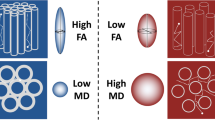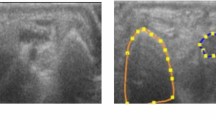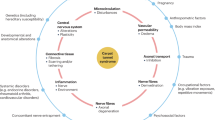Abstract
Damage to the median nerve within the carpal tunnel gives rise to carpal tunnel syndrome (CTS), which is associated with a wide spectrum of symptoms. The predominant classic symptoms are nocturnal pain of the hand, and sensory disturbances within the distribution of the median nerve, both of which are characteristically relieved by hand movements. Ancillary tests, including nerve conduction studies (NCS) and imaging techniques, are mainly indicated when the classic defining features are absent. NCS are less accurate in the early stages of CTS, and in younger patients. Imaging tests (ultrasound and MRI), while still having a lower diagnostic accuracy than NCS, are proving to be useful for explaining persistence of symptoms following surgical relief. Supplementary tests of small nerve fiber function and measurement of intracarpal pressure might, in the future, improve early recognition of CTS, especially in the absence of well-defined symptoms.
Key Points
-
Carpal tunnel syndrome is diagnosed in the presence of primary symptoms, which include nocturnal paresthesias relieved by hand movements, hand pain and/or paresthesias evoked by hand force, and sensory symptoms in digits 1, 2, 3 or part of the 4th digit, or in any combination of these digits
-
Clinical provocative tests (e.g. Phalen's or Tinel's test) are useful for supporting a diagnosis of CTS when used in a standardized and well-defined fashion
-
Nerve conduction studies are the initial investigation of choice in the presence of upper limb features without primary CTS symptoms
-
The evaluation of failed CTS release operations is best performed using imaging methods such as ultrasound or MRI
-
Carpal tunnel pressure measurement might prove valuable for documenting sufficient reduction in intracarpal pressure during surgery
This is a preview of subscription content, access via your institution
Access options
Subscribe to this journal
Receive 12 print issues and online access
$189.00 per year
only $15.75 per issue
Buy this article
- Purchase on SpringerLink
- Instant access to full article PDF
Prices may be subject to local taxes which are calculated during checkout
Similar content being viewed by others
References
Jablecki CK et al. (2002) Second AAEM literature review of the usefulness of nerve conduction studies and needle electromyography for the evaluation of patients with carpal tunnel syndrome. Muscle Nerve 25: 918–922
Bland JD (2005) Carpal tunnel syndrome. Curr Opin Neurol 18: 581–585
Brain WR et al. (1947) Spontaneous compression of both median nerves in the carpal tunnel. Lancet 1: 277–282
Phalen GS (1951) Spontaneous compression of the median nerve at the wrist. J Am Med Assoc 145: 1128–1133
Brown WF et al. (1976) The location of conduction abnormalities in human entrapment neuropathies. Can J Neurol Sci 3: 111–122
Phalen GS (1970) Reflections on 21 years' experience with the carpal-tunnel syndrome. JAMA 212: 1365–1367
You H et al. (1999) Relationships between clinical symptom severity scales and nerve conduction measures in carpal tunnel syndrome. Muscle Nerve 22: 497–501
[No authors listed] (1993) Practice parameter for electrodiagnostic studies in carpal tunnel syndrome: summary statement. American Association of Electrodiagnostic Medicine, American Academy of Neurology, American Academy of Physical Medicine and Rehabilitation. Muscle Nerve 16: 1390–1391
Atroshi I et al. (1999) Prevalence of carpal tunnel syndrome in a general population. JAMA 282: 153–158
Nora DB et al. (2005) What symptoms are truly caused by median nerve compression in carpal tunnel syndrome? Clin Neurophysiol 116: 275–283
Sharma V and Wilder-Smith EP (2004) Self-administered hand symptom diagram for carpal tunnel syndrome diagnosis. J Hand Surg [Br] 29: 571–574
Stevens JC et al. (1999) Symptoms of 100 patients with electromyographically verified carpal tunnel syndrome. Muscle Nerve 22: 1448–1456
Slipman CW et al. (1998) Symptom provocation of fluoroscopically guided cervical nerve root stimulation: are dynatomal maps identical to dermatomal maps? Spine 23: 2235–2242
Kamath V and Stothard J (2003) A clinical questionnaire for the diagnosis of carpal tunnel syndrome. J Hand Surg [Br] 28: 455–459
Torebjork HE et al. (1984) Referred pain from intraneural stimulation of muscle fascicles in the median nerve. Pain 18: 145–156
MacDermid JC and Wessel J (2004) Clinical diagnosis of carpal tunnel syndrome: a systematic review. J Hand Ther 17: 309–319
Pagel KJ et al. (2002) Lack of utility of Semmes-Weinstein monofilament testing in suspected carpal tunnel syndrome. Am J Phys Med Rehabil 81: 597–600
Massy-Westropp N et al. (2000) A systematic review of the clinical diagnostic tests for carpal tunnel syndrome. J Hand Surg [Am] 25: 120–127
Heller L et al. (1986) Evaluation of Tinel's and Phalen's signs in diagnosis of the carpal tunnel syndrome. Eur Neurol 25: 40–42
Bruske J et al. (2002) The usefulness of the Phalen test and the Hoffmann-Tinel sign in the diagnosis of carpal tunnel syndrome. Acta Orthop Belg 68: 141–145
Gerr F and Letz R (1998) The sensitivity and specificity of tests for carpal tunnel syndrome vary with the comparison subjects. J Hand Surg [Br] 23: 151–155
de Krom MC et al. (1990) Efficacy of provocative tests for diagnosis of carpal tunnel syndrome. Lancet 335: 393–395
Smith NJ (2002) Nerve conduction studies for carpal tunnel syndrome: essential prelude to surgery or unnecessary luxury? J Hand Surg [Br] 27: 83–85
Jablecki CK et al. (1993) Literature review of the usefulness of nerve conduction studies and electromyography for the evaluation of patients with carpal tunnel syndrome. Muscle Nerve 16: 1392–1414
Witt JC et al. (2004) Carpal tunnel syndrome with normal nerve conduction studies. Muscle Nerve 29: 515–522
Bland JD (2005) The relationship of obesity, age, and carpal tunnel syndrome: more complex than was thought? Muscle Nerve 32: 527–532
Jablecki CK et al. (2002) Practice parameter: electrodiagnostic studies in carpal tunnel syndrome. Report of the American Association of Electrodiagnostic Medicine, American Academy of Neurology, and the American Academy of Physical Medicine and Rehabilitation. Neurology 58: 1589–1592
Gupta R et al. (2004) Chronic nerve compression induces local demyelination and remyelination in a rat model of carpal tunnel syndrome. Exp Neurol 187: 500–508
Luchetti R et al. (1990) Carpal tunnel syndrome: correlations between pressure measurement and intraoperative electrophysiological nerve study. Muscle Nerve 13: 1164–1168
Bland JD (2000) A neurophysiological grading scale for carpal tunnel syndrome. Muscle Nerve 23: 1280–1283
Hirata H et al. (2005) MMP-2 expression is associated with rapidly proliferative arteriosclerosis in the flexor tenosynovium and pain severity in carpal tunnel syndrome. J Pathol 205: 443–450
Seror P (2001) Simplified orthodromic inching test in mild carpal tunnel syndrome. Muscle Nerve 24: 1595–1600
Robinson LR et al. (1998) Strategies for analyzing nerve conduction data: superiority of a summary index over single tests. Muscle Nerve 21: 1166–1171
Preston DC and Logigian EL (1992) Lumbrical and interossei recording in carpal tunnel syndrome. Muscle Nerve 15: 1253–1257
Dennerlein JT et al. (2002) Longer distal motor latency predicts better outcomes of carpal tunnel release. J Occup Environ Med 44: 176–183
Finsen V and Russwurm H (2001) Neurophysiology not required before surgery for typical carpal tunnel syndrome. J Hand Surg [Br] 26: 61–64
Bland JD (2001) Do nerve conduction studies predict the outcome of carpal tunnel decompression? Muscle Nerve 24: 935–940
Jordan R et al. (2002) A systematic review of the utility of electrodiagnostic testing in carpal tunnel syndrome. Br J Gen Pract 52: 670–673
Fowler TJ and Ochoa J (1975) Unmyelinated fibres in normal and compressed peripheral nerves of the baboon: a quantitative electron microscopic study. Neuropathol Appl Neurobiol 1: 247–265
Verghese J et al. (2000) Autonomic dysfunction in idiopathic carpal tunnel syndrome. Muscle Nerve 23: 1209–1213
Lehtinen I et al. (1996) Sleep-related disorders in carpal tunnel syndrome. Acta Neurol Scand 93: 360–365
Arendt-Nielsen L et al. (1991) Involvement of thin afferents in carpal tunnel syndrome: evaluated quantitatively by argon laser stimulation. Muscle Nerve 14: 508–514
Wilder-Smith EP et al. (2003) Vasomotor dysfunction in carpal tunnel syndrome. Muscle Nerve 28: 582–586
Nishimura A et al. (2003) Objective evaluation of sensory function in patients with carpal tunnel syndrome using the current perception threshold. J Orthop Sci 8: 625–628
Phalen GS (1966) The carpal-tunnel syndrome: seventeen years' experience in diagnosis and treatment of six hundred fifty-four hands. J Bone Joint Surg Am 48: 211–228
Gupta R and Steward O (2003) Chronic nerve compression induces concurrent apoptosis and proliferation of Schwann cells. J Comp Neurol 461: 174–186
Cudlip SA et al. (2002) Magnetic resonance neurography studies of the median nerve before and after carpal tunnel decompression. J Neurosurg 96: 1046–1051
Nakamichi KI and Tachibana S (2000) Enlarged median nerve in idiopathic carpal tunnel syndrome. Muscle Nerve 23: 1713–1718
Jarvik JG et al. (2004) Diagnosis of carpal tunnel syndrome: electrodiagnostic and MR imaging evaluation. Neuroimaging Clin N Am 14: 93–102
Wong SM et al. (2004) Carpal tunnel syndrome: diagnostic usefulness of sonography. Radiology 232: 93–99
Ziswiler HR et al. (2005) Diagnostic value of sonography in patients with suspected carpal tunnel syndrome: a prospective study. Arthritis Rheum 52: 304–311
Koyuncuoglu HR et al. (2005) The value of ultrasonographic measurement in carpal tunnel syndrome in patients with negative electrodiagnostic tests. Eur J Radiol 56: 365–369
Jarvik JG et al. (2002) MR nerve imaging in a prospective cohort of patients with suspected carpal tunnel syndrome. Neurology 58: 1597–1602
Keberle M et al. (2000) Technical advances in ultrasound and MR imaging of carpal tunnel syndrome. Eur Radiol 10: 1043–1050
Uchiyama S et al. (2005) Quantitative MRI of the wrist and nerve conduction studies in patients with idiopathic carpal tunnel syndrome. J Neurol Neurosurg Psychiatry 76: 1103–1108
El-Karabaty H et al. (2005) The effect of carpal tunnel release on median nerve flattening and nerve conduction. Electromyogr Clin Neurophysiol 45: 223–227
Schuind F (2002) Canal pressures before, during, and after endoscopic release for idiopathic carpal tunnel syndrome. J Hand Surg [Am] 27: 1019–1025
Okutsu I et al. (2001) Intraneural median nerve pressure in carpal tunnel syndrome. J Hand Surg [Br] 26: 155–156
Cobb TK et al. (1992) The carpal tunnel as a compartment: an anatomic perspective. Orthop Rev 21: 451–453
Cobb TK et al. (1995) Pressure dynamics of the carpal tunnel and flexor compartment of the forearm. J Hand Surg [Am] 20: 193–198
Luchetti R et al. (1990) Carpal tunnel syndrome: correlations between pressure measurement and intraoperative electrophysiological nerve study. Muscle Nerve 13: 1164–1168
Luchetti R et al. (1994) Serial overnight recordings of intracarpal canal pressure in carpal tunnel syndrome patients with and without wrist splinting. J Hand Surg [Br] 19: 35–37
Luchetti R et al. (1998) Correlation of segmental carpal tunnel pressures with changes in hand and wrist positions in patients with carpal tunnel syndrome and controls. J Hand Surg [Br] 23: 598–602
Sud V et al. (2002) Absorptive properties of synovium harvested from the carpal tunnel. Microsurgery 22: 316–319
Hamanaka I et al. (1995) Evaluation of carpal canal pressure in carpal tunnel syndrome. J Hand Surg [Am] 20: 848–854
Yoshida A and Okutsu I (2004) Relationship of carpal canal contents volume to carpal canal pressure in carpal tunnel syndrome patients. J Hand Surg [Br] 29: 277–280
Hashizume H et al. (1997) Endoscopic carpal tunnel pressure measurement: a reliable technique for complete release. Acta Med Okayama 51: 105–110
Michelsen H and Posner MA (2002) Medical history of carpal tunnel syndrome. Hand Clin 18: 257–268
Jackson DA and Clifford JC (1989) Electrodiagnosis of mild carpal tunnel syndrome. Arch Phys Med Rehabil 70: 199–204
Nathan PA et al. (1988) Sensory segmental latency values of the median nerve for a population of normal individuals. Arch Phys Med Rehabil 69: 499–501
Walters RJL and Murray NMF (2001) Transcarpal motor conduction velocity in carpal tunnel syndrome. Muscle Nerve 24: 966–968
El Miedany YM et al. (2004) Ultrasonography versus nerve conduction study in patients with carpal tunnel syndrome: substantive or complementary tests? Rheumatology (Oxford) 43: 887–895
Yesildag A et al. (2004) The role of ultrasonographic measurements of the median nerve in the diagnosis of carpal tunnel syndrome. Clin Radiol 59: 910–915
Author information
Authors and Affiliations
Corresponding author
Ethics declarations
Competing interests
The authors declare no competing financial interests.
Rights and permissions
About this article
Cite this article
Wilder-Smith, E., Seet, R. & Lim, E. Diagnosing carpal tunnel syndrome—clinical criteria and ancillary tests. Nat Rev Neurol 2, 366–374 (2006). https://doi.org/10.1038/ncpneuro0216
Received:
Accepted:
Issue date:
DOI: https://doi.org/10.1038/ncpneuro0216
This article is cited by
-
Feasibility of artificial intelligence assisted quantitative muscle ultrasound in carpal tunnel syndrome
BMC Musculoskeletal Disorders (2023)
-
The evaluation of vitamin D levels in patients with carpal tunnel syndrome
Neurological Sciences (2016)
-
Outcomes and cost-effectiveness of carpal tunnel injections using sonographic needle guidance
Clinical Rheumatology (2014)
-
Symptoms, signs and nerve conduction velocities in patients with suspected carpal tunnel syndrome
BMC Musculoskeletal Disorders (2013)
-
Sonographically guided hydrodissection and corticosteroid injection for scleroderma hand
Clinical Rheumatology (2011)



